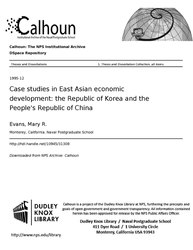File:Case studies in East Asian economic development- the Republic of Korea and the People's Republic of China (IA casestudiesineas1094531308).pdf

Original file (1,275 × 1,650 pixels, file size: 6.07 MB, MIME type: application/pdf, 147 pages)
Captions
Captions
Summary[edit]
| Case studies in East Asian economic development: the Republic of Korea and the People's Republic of China
( |
||
|---|---|---|
| Author |
Evans, Mary R. |
|
| Title |
Case studies in East Asian economic development: the Republic of Korea and the People's Republic of China |
|
| Publisher |
Monterey, California. Naval Postgraduate School |
|
| Description |
Since the end of the Cold War, economic strength has become the leading symbol of power and means of achieving peace and stability. East Asia is widely viewed as the up-and-Coming economic power center. Examination of East Asian economic development can provide some useful insights into overall patterns of development and influence, and suggest the path to a post-Cold War world future of peace and prosperity. This thesis provides two representative case studies: the Republic of Korea and the People's Republic of China. These studies emphasize the importance of external (foreign) development assistance to modernization in lesser developed countries (LDCs) and the roles played by the United States and Japan as the world's major sources of such assistance. Findings include: (1) LDCs can make extensive use of foreign development assistance without losing control -- or sovereignty -- over their economies of the direction of their development; (2) mature, industrialized economies can provide large amounts of assistance to LDCs without destroying their own economic futures; (3) the experience of the East Asians can provide useful alternatives for LDCs worldwide; and (4) a partnership has emerged between the United States and Japan as sources of development assistance. Subjects: |
|
| Language | English | |
| Publication date |
December 1995 publication_date QS:P577,+1995-12-00T00:00:00Z/10 |
|
| Current location |
IA Collections: navalpostgraduateschoollibrary; fedlink |
|
| Accession number |
casestudiesineas1094531308 |
|
| Source | ||
| Permission (Reusing this file) |
This publication is a work of the U.S. Government as defined in Title 17, United States Code, Section 101. As such, it is in the public domain, and under the provisions of Title 17, United States Code, Section 105, may not be copyrighted. | |
Licensing[edit]
| Public domainPublic domainfalsefalse |
This work is in the public domain in the United States because it is a work prepared by an officer or employee of the United States Government as part of that person’s official duties under the terms of Title 17, Chapter 1, Section 105 of the US Code.
Note: This only applies to original works of the Federal Government and not to the work of any individual U.S. state, territory, commonwealth, county, municipality, or any other subdivision. This template also does not apply to postage stamp designs published by the United States Postal Service since 1978. (See § 313.6(C)(1) of Compendium of U.S. Copyright Office Practices). It also does not apply to certain US coins; see The US Mint Terms of Use.
|
 | |
| This file has been identified as being free of known restrictions under copyright law, including all related and neighboring rights. | ||
https://creativecommons.org/publicdomain/mark/1.0/PDMCreative Commons Public Domain Mark 1.0falsefalse
File history
Click on a date/time to view the file as it appeared at that time.
| Date/Time | Thumbnail | Dimensions | User | Comment | |
|---|---|---|---|---|---|
| current | 11:10, 15 July 2020 |  | 1,275 × 1,650, 147 pages (6.07 MB) | Fæ (talk | contribs) | FEDLINK - United States Federal Collection casestudiesineas1094531308 (User talk:Fæ/IA books#Fork8) (batch 1993-2020 #10915) |
You cannot overwrite this file.
File usage on Commons
The following page uses this file:
Metadata
This file contains additional information such as Exif metadata which may have been added by the digital camera, scanner, or software program used to create or digitize it. If the file has been modified from its original state, some details such as the timestamp may not fully reflect those of the original file. The timestamp is only as accurate as the clock in the camera, and it may be completely wrong.
| Short title | Case studies in East Asian economic development: the Republic of Korea and the People's Republic of China |
|---|---|
| Author | Evans, Mary R. |
| Software used | Evans, Mary R. |
| Conversion program | Recoded by LuraDocument PDF v2.46 |
| Encrypted | no |
| Page size | 612 x 792 pts (letter) |
| Version of PDF format | 1.4 |

